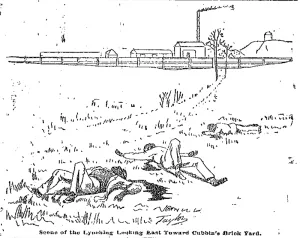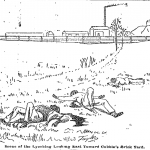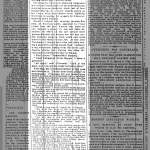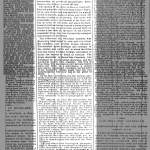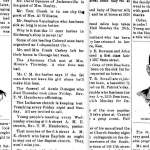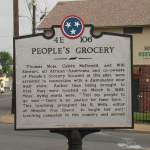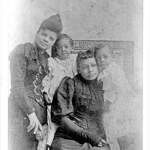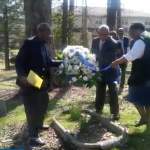Historically, the Peoples Grocery Lynching is one of the most important lynchings in American history for at least two reasons. First, it caused a large proportion of the African-American community to flee Memphis. Second, it convinced Ida B. Wells to conduct a census of lynchings which systemically researched, catalogued, categorized, and analyzed lynchings in America. Two of her most famous works on the topic were Southern Horrors: Lynch Law in All Its Phases (1892) and A Red Record: Tabulated Statistics and Alleged Causes of Lynching in the United States, 1892, 1893, and 1894 (1895). In an era when grand social theorizing with little data was in fashion, and when data collection and analysis was incredibly difficult without computers, Ida B. Wells was a forward thinking and rigorous data-driven social scientist a half century ahead of her time. (She was a genius who had read every published work by Shakespeare and Dickens by age 20.) She founded the field of empirical and systematic studies of lynchings. The fact that the 1892 lynching in Memphis motivated Wells to found this field adds additional historical importance to the site.
The lynching brought bad national media attention to Memphis, and it appears as if the city in 1892 did what it could in the immediate aftermath to make sure the whole event was swept under the rug. This in combination with other factors added difficulties to rediscovering the site today.
While there are several accounts of the lynching, even relatively recent accounts, to the best of my knowledge, none of these accounts specify the location of the lynching in accordance with the current 2017 lay of the land. For examples, accounts discuss a rail yard which no longer exists, roads whose paths have been altered, and street names that have been changed. Given the historical importance of this act of violence, it seems appropriate to find the location, if for no other reason, to help ensure the site is not again lost to history.
Given the evidence available, the old Chesapeake & Ohio rail yard, where the lynching occurred, appears to be (in terms of 2017 geography) approximately north of Keel Avenue, east of the Wolf River, south of Waterworks Avenue (if Waterworks Avenue extended further west as it had in the past), and west of Front Street. This is based on comparing page 0b of Volume 1 of the 1897 Sanborn map of Memphis with the 2017 Google map of the same location.
The book, They Say (2007) by James West Davidson draws extensively from newspaper accounts from the time of the lynching. The lynching was east of the Cheaspeake & Ohio railroad track (Davidson 136). Further, the lynching seems to have occurred directly west of the Cubbin’s Brickworks (Davidson 147). According to page 0b of Volume 1 of the 1897 Sanborn map of Memphis, the Cubbin’s Brickworks was located on the east side of New Randolph (now 2nd street). The street that would later be called Waterworks Avenue appears to end right in front of the Cubbin’s Brickworks. If the illustration at the beginning of this piece is to be believed, it would appear as if the bodies were left just south of what would become Waterworks Avenue, as the bodies lay to the right side of a path that leads to what appears to be the Brickworks (See also Davidson 145-147). Therefore, by 2017 geography, the site where the bodies were left seems to be somewhere southwest of where Waterworks Ave. currently dead ends.
I hope the work that has been done here helps future scholarship have an easier time piecing the puzzle of March 9th, 1892 together. In the attachment below, I list some sources that are useful with respect to better understanding the Peoples Grocery Lynching, locating the site of the lynching, and educational/research resources on lynching.
About This Piece
This piece was written by Mahendra Prasad, adapted from an earlier draft he wrote in 2015. A native Memphian, he is a PhD candidate in political science at UC Berkeley. He may be contacted at mrprasad@berkeley.edu. There are still many important lynching sites in the Memphis area which have not been rediscovered. If you are interested in locating more of these important lost sites, please don’t hesitate to contact me.
For More Information
Brief Material to Learn More About the Peoples Grocery Lynching:
- Lynching Sites Project's "People's Grocery" map/info page
- “Peoples Grocery” entry in Wikipedia: https://en.wikipedia.org/wiki/Peoples_Grocery
More In-Depth Material:
- Ida: A Sword Among Lions by Paula Giddings (2009)
- Southern Horrors: Lynch Law in All Its Phases by Ida B. Wells (1892)
- A Red Record: Tabulated Statistics and Alleged Causes of Lynching in the United States, 1892, 1893, and 1894 by Ida B. Wells (1895)
Helpful Sources for Locating the Site:
- 1892 Memphis City Directory
- Sanborn Maps of Memphis 1888, 1897, and 1907 editions
- They Say by James West Davidson (2007)
- Tri-State Defender article from 2/12/2005 (in the Ida B. Wells file of the Memphis Room of the Benjamin Hooks Library.)
- The Memphis Trolley and Railroad Museum
Organizations Involved in Lynching Sites Research and Education:
- The Association for the Study of African American Life and History: https://asalh100.org
- The Benjamin L. Hooks Institute for Social Change: https://www.memphis.edu/benhooks
- The Equal Justice Initiative: https://eji.org/reports/lynching-in-america
- The LeMoyne-Owen College Center for African and African-American Studies: https://www.loc.edu/academic-affairs/cfaas/default.asp
- The Lynching Sites Project of Memphis: https://lynchingsitesmem.org
- The Slave Haven Underground Railroad Museum: https://www.slavehavenmemphis.com

